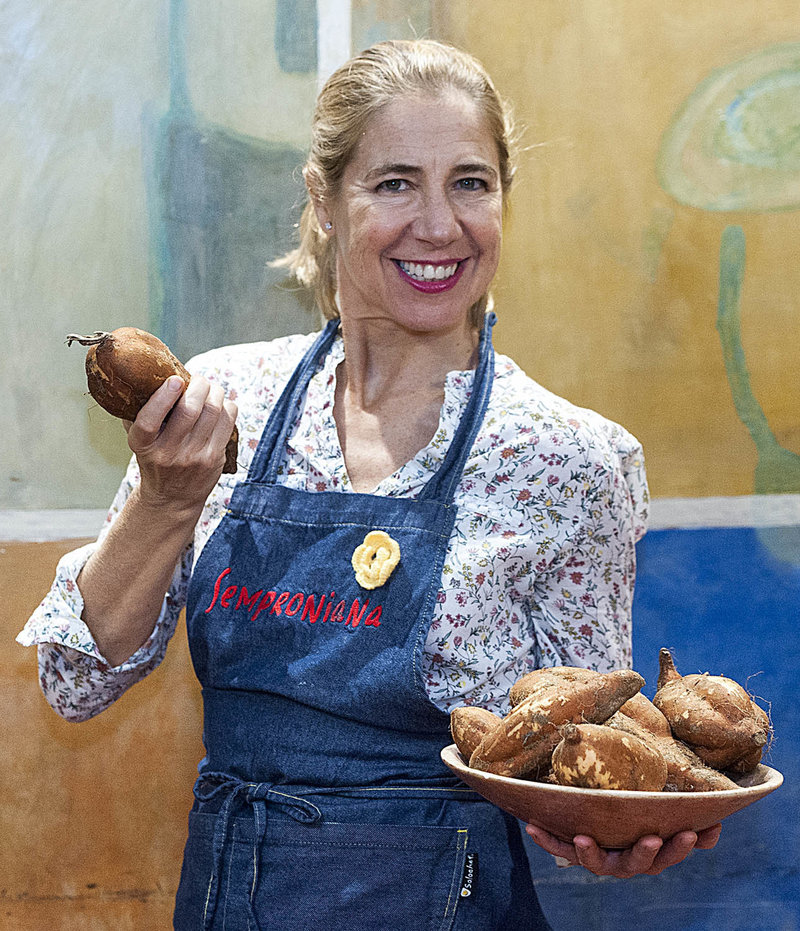I use them in cakes: I substitute part of the flour with chestnut powder If there’s something we Catalans like its wild mushrooms, we’re mad about bolets
Pumpkin soup is now common everywhere, and kids love it I use chestnuts a lot, and freeze them as their season is very short
Chef Ada Parellada is known for her love of local, seasonal products at her Semproniana restaurant (carrer Rosselló, 148, Barcelona). As autumn fruits are the protagonists of her menus at this time of the year, she gives us a few tips about the ones she uses most and tells us how she transforms them into delicious recipes. A visit to Semproniana, and a taste of her surprising, traditional but innovative and sophisticated food, will not leave you indifferent.
Let’s start with pumpkins. You even published a book about it, 10 maneres de cuinar la carbassa.
It used to be food for the poor, now it is a fashionable vegetable. As a kid, I almost never ate pumpkin: before, pumpkins were used more for cabell d’angel, and of course to feed animals. Pumpkin soup is now common everywhere, kids like it and we do more and more with it. The pumpkins we used years ago had less colour, more fibre and were more difficult to peel; nowadays we have butternut squash, a type of pumpkin that is finer, with less fibre, more colour, smaller, and with the seeds concentrated at the base. As for myself, I discovered that the best way to cook it is to roast it, as it keeps all the juices and has more taste. Then I empty it, mix it with sofregit (fried onion and garlic) and boil, and you have a delicious soup. I also make trinxats de carbassa, where I substitute part of the potato with pumpkin, mixed with cansalada bacon and cabbage, or kale. And I love to use sweet potatoes instead of potatoes. Pumpkin also makes a great side dish to go with fish: I dice it and then sautée it in olive oil, it is easy to make. The colours are beautiful, and it goes great with any fish.
Why is pumpkin a favourite?
Because it gives you everything: it’s easy to cook, and has taste and colour, all you need to be successful in a professional kitchen. I like to cook for kids and it’s always a hit with them. One good recipe: peel some thin pumpkin, and make a delicious carpaccio with some ham and a mustard vinaigrette, it’s marvellous. Use your imagination, and add anything you like.
And chestnuts?
Delicious, but not obvious. It’s not an easy product as it is more expensive and often comes from other places. There are Catalan chestnuts, but there are a lot of Galician chestnuts on sale here, and I prefer using local products. I use them quite a lot, and I tend to freeze them as their season is very short. I scald them in order to peel them easier, then I freeze them, and so can use them for much longer. It’s a food that fills you up. They’re not used at lot here in homes, although they go great with meat, especially pork, duck, or chicken. For me, there are two things about chestnuts: one is a powder I use in desserts. I grind them to use them in cakes: I substitute part of the flour with chestnut powder, and the resulting taste is out of this world. Yet, it is an expensive product, and quite difficult to manipulate because of its skin. I also make an omelette with them, quite creamy, not too cooked inside, with mushrooms, chestnuts and a bit of fresh foie. A wonderful combination of different textures, with the crunchy surprise of chestnuts! I’ve made it for years and works really well.
And now mushrooms...
If there’s something we Catalans like its mushrooms, we’re mad about bolets. This is a great year for wild mushrooms, as it has rained a lot and they are exceptional right now, and at a very good price. My favourites are rossinyols (golden chanterelle), and like everyone else of course I love the king of mushrooms, the ou de reig (Caesar’s mushroom), but also more humble mushrooms such as moixerons (St. George’s mushroom) and camagrocs (yellow foot). Now they’ve discovered a mushroom called the gírgola del castanyer (hen of the woods), which as the name says, grows on the trunks of chestnut trees. And it is also cultivated, which makes it more regular, thanks to a Catalan company from Montseny. They make a great dish that just takes seven minutes in the oven with oil and salt. Typical recipes with mushrooms: scrambled eggs with camagrocs, sautéed to go with any meat or fish dish, rice with bolets, which never fails. I even made a combination which many doubted but that’s become much appreciated: a bolet cassoulet with cheese sauce, mixed fredolics (grey knight), rossinyols and rovellons (saffron milk cap), and a light cheese cream with gratinated cheese.
And last but not least, sweet potatoes.
A marvellous one is my sweet potato fries, cooked in the oven for 20 minutes with salt and oil, in their skins, great to accompany any dish. Also sweet potato bravas, first poached with oil and then fried in very hot oil, and served with a hot green sauce.
What other autumn products do you have a special preference for?
Two quite unknown ones, but very interesting: quince very good with roast meat, and persimmons, which are in season now. They’re delicious, like honey and nectar, and I’d like to use them more in desserts, with yoghurt or tiramisu with mascarpone.
FOOD interview

